Thursday, January 10th 2019

AMD Radeon VII Detailed Some More: Die-size, Secret-sauce, Ray-tracing, and More
AMD pulled off a surprise at its CES 2019 keynote address, with the announcement of the Radeon VII client-segment graphics card targeted at gamers. We went hands-on with the card earlier this week. The company revealed a few more technical details of the card in its press-deck for the card. To begin with, the company talks about the immediate dividends of switching from 14 nm to 7 nm, with a reduction in die-size from 495 mm² on the "Vega 10" silicon to 331 mm² on the new "Vega 20" silicon. The company has reworked the die to feature a 4096-bit wide HBM2 memory interface, the "Vega 20" MCM now features four 32 Gbit HBM2 memory stacks, which make up the card's 16 GB of memory. The memory clock has been dialed up to 1000 MHz from 945 MHz on the RX Vega 64, which when coupled with the doubled bus-width, works out to a phenomenal 1 TB/s memory bandwidth.
We know from AMD's late-2018 announcement of the Radeon Instinct MI60 machine-learning accelerator based on the same silicon that "Vega 20" features a total of 64 NGCUs (next-generation compute units). To carve out the Radeon VII, AMD disabled 4 of these, resulting in an NGCU count of 60, which is halfway between the RX Vega 56 and RX Vega 64, resulting in a stream-processor count of 3,840. The reduced NGCU count could help AMD harvest the TSMC-built 7 nm GPU die better. AMD is attempting to make up the vast 44 percent performance gap between the RX Vega 64 and the GeForce RTX 2080 with a combination of factors.First, AMD appears to be maximizing the clock-speed headroom achieved from the switch to 7 nm. The Radeon VII can boost its engine clock all the way up to 1800 MHz, which may not seem significantly higher than the on-paper 1545 MHz boost frequency of the RX Vega 64, but the Radeon VII probably sustains its boost frequencies better. Second, the slide showing the competitive performance of Radeon VII against the RTX 2080 pins its highest performance gains over the NVIDIA rival in the "Vulkan" title "Strange Brigade," which is known to heavily leverage asynchronous-compute. AMD continues to have a technological upper-hand over NVIDIA in this area. AMD mentions "enhanced" asynchronous-compute for the Radeon VII, which means the company may have improved the ACEs (async-compute engines) on the "Vega 20" silicon, specialized hardware that schedule async-compute workloads among the NGCUs. With its given specs, the Radeon VII has a maximum FP32 throughput of 13.8 TFLOP/s
The third and most obvious area of improvement is memory. The "Vega 20" silicon is lavishly endowed with 16 GB of "high-bandwidth cache" memory, which thanks to the doubling in bus-width and increased memory clocks, results in 1 TB/s of memory bandwidth. Such high physical bandwidth could, in theory, allow AMD's designers to get rid of memory compression which probably frees up some of the GPU's number-crunching resources. The memory size also helps. AMD is once again throwing brute bandwidth to overcome any memory-management issues its architecture may have.The Radeon VII is being extensively marketed as a competitor to GeForce RTX 2080. NVIDIA holds a competitive edge with its hardware being DirectX Raytracing (DXR) ready, and even integrated specialized components called RT cores into its "Turing" GPUs. The "Vega 20" continues to lack such components, however AMD CEO Dr. Lisa Su confirmed at her post-keynote press round-table that the company is working on ray-tracing. "I think ray tracing is important technology; it's something that we're working on as well, from both a hardware/software standpoint."
Responding to a specific question by a reporter on whether AMD has ray-tracing technology, Dr. Su said: "I'm not going to get into a tit for tat, that's just not my style. So I'll tell you that. What I will say is ray tracing is an important technology. It's one of the important technologies; there are lots of other important technologies and you will hear more about what we're doing with ray tracing. You know, we certainly have a lot going on, both hardware and software, as we bring up that entire ecosystem."
One way of reading between the lines would be - and this is speculation on our part - that AMD could working on retrofitting some of its GPUs powerful enough to handle raytracing with DXR support through a future driver update, as well as working on future generations of GPUs with hardware-acceleration for many of the tasks that are required to get hybrid rasterization work (adding real-time raytraced objects to rasterized 3D scenes). Just as real-time raytracing is technically possible on "Pascal" even if daunting on the hardware, with good enough work directed at getting a ray-tracing model to work on NGCUs leveraging async-compute, some semblance of GPU-accelerated real-time ray-tracing compatible with DXR could probably be achieved. This is not a part of the feature-set of Radeon VII at launch.
The Radeon VII will be available from 7th February, priced at $699, which is on-par with the SEP of the RTX 2080, despite the lack of real-time raytracing (at least at launch). AMD could shepherd its developer-relations on future titles being increasingly reliant on asynchronous compute, the "Vulkan" API, and other technologies its hardware is good at.
We know from AMD's late-2018 announcement of the Radeon Instinct MI60 machine-learning accelerator based on the same silicon that "Vega 20" features a total of 64 NGCUs (next-generation compute units). To carve out the Radeon VII, AMD disabled 4 of these, resulting in an NGCU count of 60, which is halfway between the RX Vega 56 and RX Vega 64, resulting in a stream-processor count of 3,840. The reduced NGCU count could help AMD harvest the TSMC-built 7 nm GPU die better. AMD is attempting to make up the vast 44 percent performance gap between the RX Vega 64 and the GeForce RTX 2080 with a combination of factors.First, AMD appears to be maximizing the clock-speed headroom achieved from the switch to 7 nm. The Radeon VII can boost its engine clock all the way up to 1800 MHz, which may not seem significantly higher than the on-paper 1545 MHz boost frequency of the RX Vega 64, but the Radeon VII probably sustains its boost frequencies better. Second, the slide showing the competitive performance of Radeon VII against the RTX 2080 pins its highest performance gains over the NVIDIA rival in the "Vulkan" title "Strange Brigade," which is known to heavily leverage asynchronous-compute. AMD continues to have a technological upper-hand over NVIDIA in this area. AMD mentions "enhanced" asynchronous-compute for the Radeon VII, which means the company may have improved the ACEs (async-compute engines) on the "Vega 20" silicon, specialized hardware that schedule async-compute workloads among the NGCUs. With its given specs, the Radeon VII has a maximum FP32 throughput of 13.8 TFLOP/s
The third and most obvious area of improvement is memory. The "Vega 20" silicon is lavishly endowed with 16 GB of "high-bandwidth cache" memory, which thanks to the doubling in bus-width and increased memory clocks, results in 1 TB/s of memory bandwidth. Such high physical bandwidth could, in theory, allow AMD's designers to get rid of memory compression which probably frees up some of the GPU's number-crunching resources. The memory size also helps. AMD is once again throwing brute bandwidth to overcome any memory-management issues its architecture may have.The Radeon VII is being extensively marketed as a competitor to GeForce RTX 2080. NVIDIA holds a competitive edge with its hardware being DirectX Raytracing (DXR) ready, and even integrated specialized components called RT cores into its "Turing" GPUs. The "Vega 20" continues to lack such components, however AMD CEO Dr. Lisa Su confirmed at her post-keynote press round-table that the company is working on ray-tracing. "I think ray tracing is important technology; it's something that we're working on as well, from both a hardware/software standpoint."
Responding to a specific question by a reporter on whether AMD has ray-tracing technology, Dr. Su said: "I'm not going to get into a tit for tat, that's just not my style. So I'll tell you that. What I will say is ray tracing is an important technology. It's one of the important technologies; there are lots of other important technologies and you will hear more about what we're doing with ray tracing. You know, we certainly have a lot going on, both hardware and software, as we bring up that entire ecosystem."
One way of reading between the lines would be - and this is speculation on our part - that AMD could working on retrofitting some of its GPUs powerful enough to handle raytracing with DXR support through a future driver update, as well as working on future generations of GPUs with hardware-acceleration for many of the tasks that are required to get hybrid rasterization work (adding real-time raytraced objects to rasterized 3D scenes). Just as real-time raytracing is technically possible on "Pascal" even if daunting on the hardware, with good enough work directed at getting a ray-tracing model to work on NGCUs leveraging async-compute, some semblance of GPU-accelerated real-time ray-tracing compatible with DXR could probably be achieved. This is not a part of the feature-set of Radeon VII at launch.
The Radeon VII will be available from 7th February, priced at $699, which is on-par with the SEP of the RTX 2080, despite the lack of real-time raytracing (at least at launch). AMD could shepherd its developer-relations on future titles being increasingly reliant on asynchronous compute, the "Vulkan" API, and other technologies its hardware is good at.
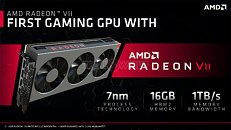
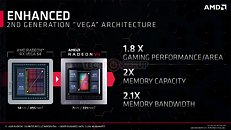
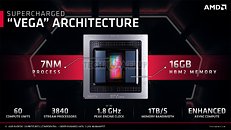
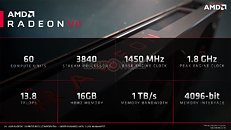
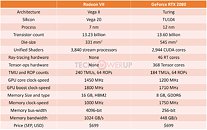
154 Comments on AMD Radeon VII Detailed Some More: Die-size, Secret-sauce, Ray-tracing, and More
I must admit I took the 128 ROPs report as given. If the Instinct diags aren't just high level basic copies of Vega10 slides, then definately 64 ROPS for Vega20.
No, great value would be if it wasn't just a Vega respin with double the memory bandwidth, double the VRAM, 250MHz higher clocks, and an extra $200 tacked on to the price. The die-shrink to 7nm is going to help with power and heat, but this is still Vega/GCN 5 with all its limitations, and I honestly don't expect this card to outperform GTX 2080 in the way AMD is claiming.
Plus lets hold off on that heat portion. Wait for the reviews, you can't complain about heat when you haven't seen the temps yet. Will it use more power? Yea sure doesn't mean its going to run hot.
This video shows the performance of a Vega 64 clocked at 1,750MHz against an RTX 2080 running at stock clocks. (Also don't forget Vega 64 has 4 more CUs than Radeon VII which makes up for that 50MHz core clock deficit)
Even the memory on the AMD side is overclocked and at those clocks the vega has 580GB of memory bandwidth which is quite a lot.
This is pretty much what you would expect from a Radeon VII to do, maybe a little bit better.
25% is not enough to be on par with RTX 2080.
But as you say, reviews will tell the truth.
13% of that performance comes from the higher boost clock of 1800 MHz (remember, 4 CU short).
12% likely comes from Radeon VII's ability to hold boost clock longer than Vega 64 does.
You know how it goes: they're likely talking about games where Vega 64 does really well against Turing. I highly doubt they're talking about an average.
I mean.... Fury, Vega (1), Vega II ... they are almost identical.
Considering that the new chip is rather small at 331 mm2, what stopped them from making a 450 mm2 chip for example and fitting 72 CU's in it, or 96 !!
It would wipe the floor with 2080 Ti with 6144 SP's (let's say cut a few for being defective, even with 5760 SP's it would still crush it with raw computer power and that massive 1TBps bandwidth, WHILE BEING A SMALLER CHIP due to 7nm)
Instead, they just shrunk Fury, then shrunk it again without adding anything :(
Even if I dont have my Vega56 I wont buy this card at all, for once it still uses the same limitation since Fiji. They only increase clockspeed and add tiny bit of improvement here and there. Only reason I bought my Vega56 is because it didnt have the dreaded 4GB limitation as Fury so new games wont choke, and I get it for cheap since mining crash.
think littel ? - stay littel
think big - get BIG
isn't that whay nvidea have money for drivers and AMD don't ? the money they get from thinking big give them drivers, when AMD fail again and again in drivers and still didn't learned that game developer relations important ? let me guess: the "solution" to developer relations is put more GB/s memory banwith and another 1000 mhz. they never learn. do wrong once, you stupid, do wrong twice you retard, do wrong 3: you insane.
AMD shills ? I can respect that, you look like a fighter too. "fight for your right for gaming on AMD, kill anyone that looks like against AMD" ?
but you could use a brain: a gaming developer relationship program will benefit AMD more than a few more mhz and a few more GB/s memory banwith
you don't see the advantage of that ? for your own good ? what does that make you ?
how about async compute enabled on all games sounds to you ? should I mention how much faster doom 4 was with async enabled ? and that was just one game where is was used.....WITHOUT AMD's help...and that's just the beginning, are you able to imagine what it could mean if AMD was involved ? in all games ?
oh wait, you are a radeon expert, im sorry you must know more than I do